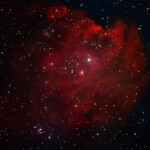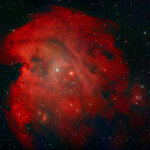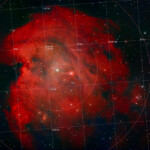NGC 2174 (also known as Monkey Head Nebula) is an H II emission nebula located in the constellation Orion and is associated with the open star cluster NGC 2175. It is thought to be located about 6,400 light-years away from Earth. The nebula may have formed through hierarchical collapse.
Glowing gas and dark dust do not survive well in the Monkey Head Nebula. Young stars near the center of the nebula generate stellar winds and high energy radiation that causes the nebula’s material to shift into complex shapes. The nebula is primarily composed of hydrogen which glows at infrared wavelengths due to the radiation.

NGC 2174, NGC 2175 and IC 2159
NGC 2174 (also known as Monkey Head Nebula) is an H II emission nebula located in the constellation Orion and is associated with the open star cluster NGC 2175. It is thought to be located about 6,400 light-years away from Earth. The nebula may have formed through hierarchical collapse.
Photographed with APO 94mm refractor telescope and ASI 2600MC color camera in Stuvsta, January 2022. Exposure was 27 * 2 min with IDAS LPS P3 light pollution filter.

NGC 2174, NGC 2175 and IC 2159
NGC 2174 (also known as Monkey Head Nebula) is an H II emission nebula located in the constellation Orion and is associated with the open star cluster NGC 2175. It is thought to be located about 6,400 light-years away from Earth. The nebula may have formed through hierarchical collapse.
Photographed with APO 94mm refractor telescope and ASI 2600MC color camera in Stuvsta, January 2022. Exposure was 27 * 2 min with IDAS LPS P3 light pollution filter.

NGC 2174, NGC 2175 and IC 2159
NGC 2174 (also known as Monkey Head Nebula) is an H II emission nebula located in the constellation Orion and is associated with the open star cluster NGC 2175. It is thought to be located about 6,400 light-years away from Earth. The nebula may have formed through hierarchical collapse.
Photographed with MN190 reflector telescope and Atik 360EX CCD camera from my garden in Stuvsta, March 2021. Exposure was 18 min RGB each, 40 min Ha and 20 min Lum.

